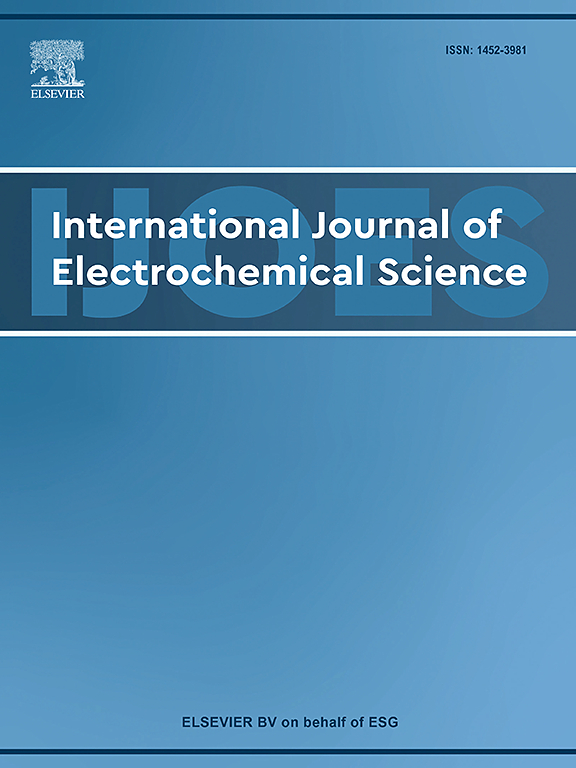用于糖尿病早期检测的二维材料电化学传感器:进展与展望
IF 2.4
4区 化学
Q4 ELECTROCHEMISTRY
International Journal of Electrochemical Science
Pub Date : 2025-07-05
DOI:10.1016/j.ijoes.2025.101123
引用次数: 0
摘要
糖尿病是一项重大且不断升级的全球健康挑战,其特点是患病率惊人,经济负担沉重。早期检测对于有效管理和预防长期并发症至关重要,但传统诊断方法在准确性、便利性、成本和捕捉动态血糖变化的能力方面存在局限性。电化学生物传感器提供了一个很有前途的替代方案,具有高灵敏度、快速响应、便携性和小型化潜力等优点。二维(2D)材料的出现,包括石墨烯、过渡金属二硫族化合物(TMDs)和MXenes,已经彻底改变了电化学传感领域。其独特的物理化学性质-包括快速电子转移的高导电性,增强分析物相互作用的大表面积,生物受体固定化的可调表面功能化,以及可穿戴集成的机械灵活性-使电化学传感器的灵敏度,选择性和操作稳定性得到实质性提高。本文综述了利用二维材料增强电化学传感器早期检测糖尿病相关关键生物标志物的进展,包括葡萄糖、糖化血红蛋白(HbA1c)、胰岛素、胰高血糖素和酮类。我们讨论了这些二维材料的基本性质,以及它们提高传感器灵敏度、选择性和稳定性的机制。传感器设计、制造策略和性能指标(检测极限、线性范围、响应时间)的最新进展,以及相关生物基质的验证研究,都进行了严格的检查。尽管取得了相当大的进展,但在材料合成的可重复性、生物环境中的长期稳定性、对生物污垢和干扰的易感性以及实现成本效益、可扩展制造和临床转化的途径等方面仍然存在挑战。讨论了未来的前景,包括探索新的二维材料和异质结构,先进的功能化技术,多路检测平台,以及集成到可穿戴和护理点系统。解决目前的障碍对于实现基于二维材料的电化学传感器在改变糖尿病诊断和管理方面的全部潜力至关重要。本文章由计算机程序翻译,如有差异,请以英文原文为准。
2D material-based electrochemical sensors for early diabetes detection: A review of progress and prospects
Diabetes mellitus represents a significant and escalating global health challenge, characterized by alarming prevalence rates and substantial economic burden. Early detection is paramount for effective management and prevention of debilitating long-term complications, yet conventional diagnostic methods face limitations in terms of accuracy, convenience, cost, and ability to capture dynamic glycemic changes. Electrochemical biosensors offer a promising alternative, providing advantages such as high sensitivity, rapid response, portability, and potential for miniaturization. The advent of two-dimensional (2D) materials, including graphene, transition metal dichalcogenides (TMDs), and MXenes, has revolutionized the field of electrochemical sensing. Their unique physicochemical properties—including high electrical conductivity for rapid electron transfer, large surface area for enhanced analyte interaction, tunable surface functionalization for bioreceptor immobilization, and mechanical flexibility for wearable integration—enable substantial improvements in sensitivity, selectivity, and operational stability of electrochemical sensors. This review provides a comprehensive overview of the progress in utilizing 2D material-enhanced electrochemical sensors for the early detection of key diabetes-related biomarkers, including glucose, glycated hemoglobin (HbA1c), insulin, glucagon, and ketones. We discuss the fundamental properties of these 2D materials and the mechanisms by which they improve sensor sensitivity, selectivity, and stability. Recent advancements in sensor design, fabrication strategies, and performance metrics (limit of detection, linear range, response time) are critically examined, along with validation studies in relevant biological matrices. Despite considerable progress, challenges remain concerning material synthesis reproducibility, long-term stability in biological environments, susceptibility to biofouling and interference, and pathways towards cost-effective, scalable manufacturing and clinical translation. Future prospects, including the exploration of novel 2D materials and heterostructures, advanced functionalization techniques, multiplexed detection platforms, and integration into wearable and point-of-care systems, are discussed. Addressing the current hurdles will be crucial for realizing the full potential of 2D material-based electrochemical sensors in transforming diabetes diagnostics and management.
求助全文
通过发布文献求助,成功后即可免费获取论文全文。
去求助
来源期刊
CiteScore
3.00
自引率
20.00%
发文量
714
审稿时长
2.6 months
期刊介绍:
International Journal of Electrochemical Science is a peer-reviewed, open access journal that publishes original research articles, short communications as well as review articles in all areas of electrochemistry: Scope - Theoretical and Computational Electrochemistry - Processes on Electrodes - Electroanalytical Chemistry and Sensor Science - Corrosion - Electrochemical Energy Conversion and Storage - Electrochemical Engineering - Coatings - Electrochemical Synthesis - Bioelectrochemistry - Molecular Electrochemistry

 求助内容:
求助内容: 应助结果提醒方式:
应助结果提醒方式:


